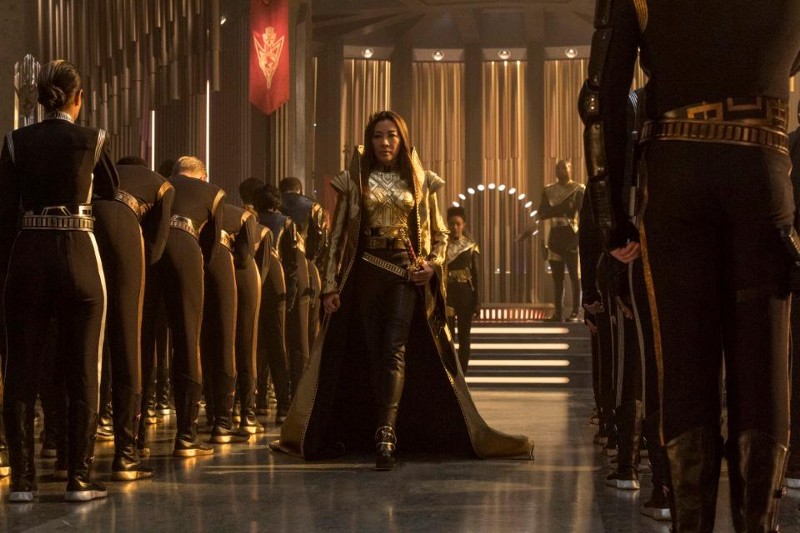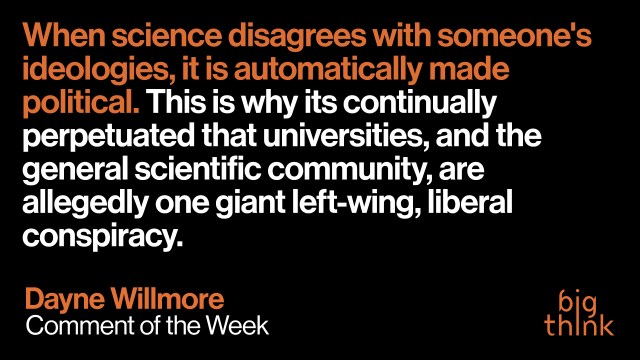‘Star Trek: Discovery,’ The No-Win Situation, And The Cause Of All Life: Season 1, Episode 13…

Plus, how the mycelium network’s destruction could, physically, actually end life in the Universe.
Imagine taking a seemingly impossible journey: traveling to another Universe on a network of biological spores that no one else had been able to harness, understand, or even discover. Then imagine you’ve discovered that the network is corrupted, all because someone in this alternate Universe is unsustainably harnessing the network as an energy source. Over time, it’s drawing energy out of the network, destroying the bridge between Universes. But it gets worse: if the network is destroyed, you aren’t just stranded in this “mirror” Universe; you discover that all life in the Universe — in all Universes — will come to an end. If you destroy the ship harnessing the spore energy, you destroy your ship and your crew, and there’s no guarantee it saves the network. It’s a no-win situation. What do you do? On the latest episode of Star Trek: Discovery, “What’s Past Is Prologue,” we find out.

Recap: Aboard Discovery, Saru, now acting as Captain, leads the crew towards their main goals now that they’ve recovered Stamets: retrieving Burnham and Lorca, getting home, and winning their own war. But it isn’t going to be easy. For one thing, the mycelium network is dying, poisoned by the Terran Empire’s and mirror Stamets’ greed in creating the core of the Emperor’s flagship. They find out that Lorca is actually mirror Lorca, and they’ve been deceived the whole time. Over on the Emperor’s ship, Emperor Georgiou’s team is fighting bravely against Lorca’s rebels, but they’re losing the battle. Commander Landry makes a reappearance, similar to Ensign Connor: someone we haven’t seen since they were killed in the prime Universe very early in the season. As usual, her only plan is an awful one, but she’s overruled by Lorca. Still, the action is too swift and the deaths are too many to get too attached to someone here.

Saru, meanwhile, finds out that there’s no way to conventionally destroy the core of the Emperor’s ship, which is dooming life in the Universe. If they weaponize the spores on board, they can do it, but Discovery’s shields will fail and they’ll all die. And then, he delivers the best (and most Star Trek-like) speech of the whole series:
“It is well-known that my species has the ability to sense the coming of death. I do not sense it today. I may not have all the answers. However, I do know that I am surrounded by a team I trust. The finest a Captain could ever hope to command. Lorca abused our idealism. Make no mistake: Discovery is no longer Lorca’s. She is ours. Today will be her maiden voyage. We have a duty to perform, and we will not accept a no-win scenario. You have your orders. On your way.”
I like Saru. He’s the closest thing we’ve seen aboard Discovery to upholding the ideals that guide the Federation in all future Star Trek series.
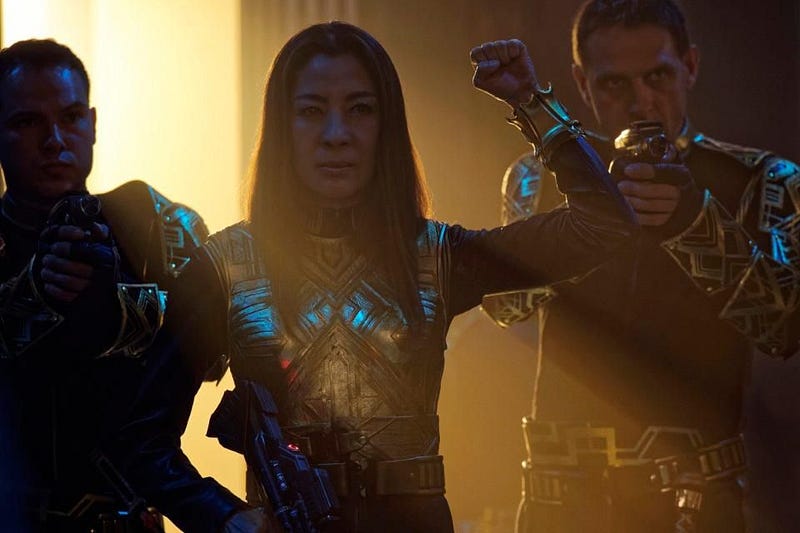
Burnham brings the Emperor to Lorca, offering herself, her mind, and her skills to Lorca in order to save Discovery’s crew. Lorca appears pleased; the ultimate believer in destiny — the destiny that propelled him from certain death into another Universe, the destiny that brought the same people together across time and space — saw prime Universe Burnham betray her Georgiou; saw mirror Universe Burnham betray the Emperor; and now sees prime Burnham betraying mirror Georgiou. Over on Discovery, Tilly discovers a potential way home: riding the mycelium wave/ripples that will be emitted from destroying the core of the Emperor’s ship. Stamets interjects that the combination of their shields and a warp bubble, if they combine the spore and warp drives, could protect them, allowing Stamets a chance to guide them home. It’s a way to win in the no-win situation.

Discovery warps to confront the Emperor’s ship, and after Saru dismisses Lorca’s pleasantries, sees the moment is right to strike when Burnham and Georgiou begin their rebellion. Discovery’s first strike hits home, rocking Lorca and his troops, allowing Burnham and Georgiou to take advantage. In an action packed fight, Lorca’s crew goes down, one by one, as Burnham and Georgiou take them all down. In the end, Burnham defeats Lorca, who’s then stabbed through the chest by Georgiou, who kicks him into the mycelium core. (The visual effects of his death are stunning.) Georgiou then offers to spend her life buying Burnham the critical moments to find a way home, and Burnham brings down the core confinement protection. But at the last minute, she rushes to grab Georgiou, saving her, against all logic and even perhaps against Georgiou’s will. Apparently, Burnham won’t accept a no-win situation either.

Landry, ever the inept commander no matter what Universe she’s in, doesn’t realize what Discovery’s aiming to do, and hasn’t even checked on core containment until now. Discovery beams Burnham and Georgiou out, triggers the core’s destruction and blows up the Emperor’s flagship, and then creates the wave for Stamets to ride home. He initially can’t see which path to take, but his prior journey through his mind, from back when he was in his coma, leads his memories of Hugh Culber to successfully guide him home. The mycelium network is intact, and they’re back in the prime Universe. The only catch is they’re nine months in the future, and the Klingons have won the war.
The Science: I have to give credit to Star Trek for going big here. If you’re going to invest in quantum biology, you might as well go all the way with it. They could have just made the mycelium network some biological overlay atop a physical framework, the way we believe things work in the actual, physical Universe. But instead, they’ve given the mycelium network an explicitly fundamental connection to the Universe’s ability to have life in it. If the network dies, life dies. Unbelievably, there is a physical way this could happen: vacuum decay.

One of the most puzzling features of the Universe is that the zero-point energy of some systems isn’t actually zero. The lowest energy state of an electron in an atom is some positive value rather than zero; so it goes for empty space itself. In our Universe today, this manifests itself as dark energy: energy inherent to the fabric of space, causing the expansion of the Universe to accelerate. There is always the possibility, though, that we’re not in the lowest-energy state at all, but in a false vacuum. That at any moment, it can decay. And if it does, this ends the Universe as we know it.

If such a vacuum decay occurred, and we transitioned to a lower-energy state, it would change the fundamental properties of the Universe. New constants of nature could emerge; all chemical and molecular bonds would be different; and all the life processes we know of would likely be impossible. If we live in a meta-stable state (i.e., a false vacuum) today, there must be some barrier to us reaching the true vacuum. While this barrier is normally taken to be part of the properties of space and quantum fields itself, Star Trek: Discoveryinserts the mycelium instead. If the spore network dies, we have vacuum decay.

In the real Universe, if this occurs, then we fully expect the new properties to expand out at the speed of light from within the bubble where the decay first occurs. Most of the Universe would be spared, in theory; from the part we can observe, we’d only be affected by it if vacuum decay occurred in the nearest 3% of volume to us. Anything from beyond that would speed away from us faster than the bubble wall can travel, owing to the very presence of the dark energy powering the Universe’s expansion. But if you have the mycelium network instead, and it stands outside the Universe (or, perhaps, in-between Universes), all bets are off. It could take effect everywhere at once, and that would be the ultimate catastrophe.
Beyond that, surfing the mycelium ripples home brings up one of the most common questions I’ve encountered, as a scientist, since the first detection LIGO made of merging black holes: is it possible to surf a gravitational wave? The answer is no in practice, but yes in theory. Gravitational waves are, literally, ripples in spacetime: additional regions of compression and rarefaction of space overlaid atop whatever else space is doing (like curving or expanding) on its own. If you could design a spacecraft that was sensitive enough to these motions that it remained “pinned” inside one of these compressed regions by the properties of gravitation, you could ride the wave as far as its energy would allow. Well, if the mycelium is analogous to this for the fabric between Universes, perhaps prime Stamets’ incredible voyage home is possible, too.
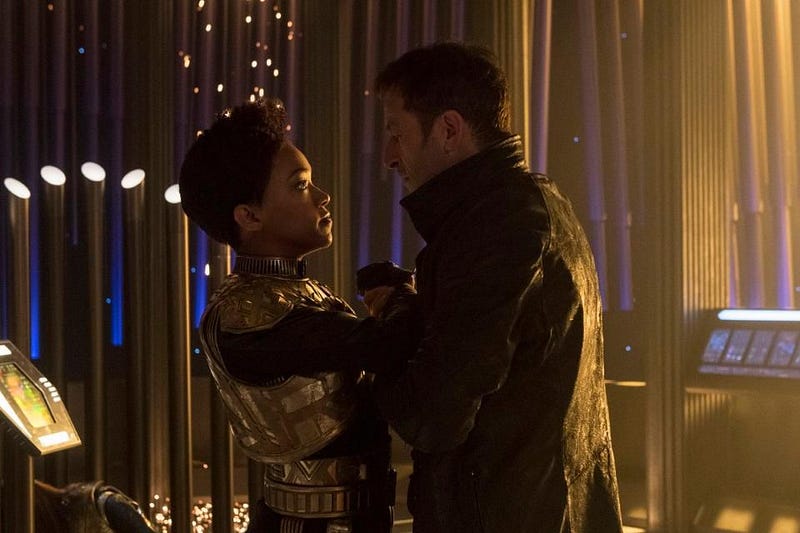
Right and Wrong: Normally, there are ethical dilemmas presented as part of a Star Trek episode. Who do you side with in a conflict? There was a tremendous opportunity to explore that with Burnham, especially given her history with Lorca, the fact that mirror Burnham was sleeping with Lorca, that he has a history of trusting her and giving her opportunities, and their mutual belief that the ends justify the means. There’s also the terror that is the Terran Empire, and the horrible acts of destruction that Emperor Georgiou has wrought upon this Universe. We have two factions led by two villains: Georgiou and Lorca. But Star Trek: Discovery doesn’t explore any of this. Instead, Burnham sides with Georgiou, then betrays her wishes one last time by “saving” her and bringing her back to the prime Universe.

If you needed proof that Lorca was a villain, Star Trek provides one with the death of mirror Stamets. Sure, that mirror Stamets doesn’t need to go for the horrific weapon he created, as well as the destruction he wrought upon the network, threatening the very possibility of life in the Universe. But when Lorca threatens to throw him into the mycelium core powering the Emperor’s ship, calling it poetic justice, and then shoots him with a phaser instead, he gives himself away. “Just kidding. I hate poetry,” is a reveal. No heroes, in any incarnation of Star Trek, are poetry-haters.

Not that Emperor Georgiou is exactly a “good guy” either, leading a species-ist, murderous empire of oppression. That latter point, featured so prominently in earlier episodes in the mirror Universe, isn’t even addressed. Instead, Burnham just has her “mommy” moment with Georgiou, and does whatever her gut tells her to do to get the outcome she wants, regardless of anyone else’s wishes. Sound familiar? It’s a regression to the worst traits of her character.
The failure to make a choice in a no-win situation is frustrating because real life is actually full of legitimate no-win situations. Back in Star Trek: The Next Generation, one of the toughest tests you had to pass to be fit for command was to send a dear friend and crewmate to their death, because it’s the only solution to the problem. Spock had to sacrifice himself in Wrath of Khan because it was the only way. It was a real missed opportunity to explore the necessity of loss for a greater victory.

In contrast to what’s happening with the Terran Empire, over on Discovery, they hold to their highest ideals even in the most extreme crises. Saru is the moral anchor of the crew, and they follow him, realizing the best versions of themselves. Tilly discovers the path out of their no-win situation; Stamets finds the extraordinarily low-probability path home; the team executes the full suite of their plans flawlessly. With Lorca gone, the crew of Discovery is finally behaving like we’re accustomed to a Starfleet crew behaving. For the first time, we see the flagship of a Star Trek show led by an unfamiliar, alien face, rather than a human one. It’s a touching reminder of what we are and can accomplish at our best, when we all band together and work towards our common goals.
With Burnham and Emperor Georgiou on board, those values are threatened. However, in this time of war, sure to be explored in the remaining two episodes of season 1, perhaps their lack of morality (as we understand it) will prove useful. We’ll find out.

Summary: Never has a crew been so indifferent to the death of their former Captain as all of Discovery was to Lorca, but here in the Terran Empire, there are no “good guys” among humans. It’s a little disturbing how easily all loyalty is lost to someone they would have followed to the edges of existence, but I suppose that’s how betrayal works: once it happens, you feel betrayed by absolutely everything about the person in question. But it’s discomfiting, especially when you look at the Universe they’re returning to.
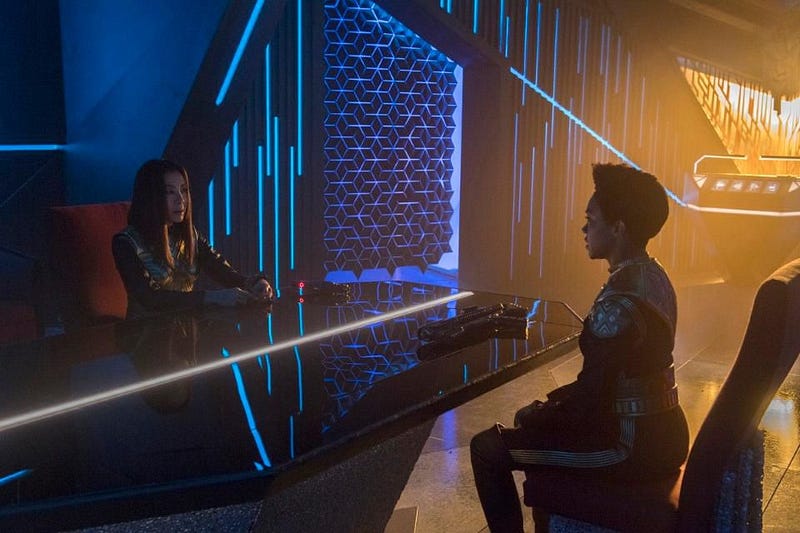
One of the frustrating things about Star Trek species is that they’re often monoliths: Klingons are honor-obsessed warriors steeped in the mythology of Kahless; Ferengi are oppressively sexist and obsessed with wealth; Vulcans are stoically devoted to logic in all circumstances. In Star Trek: Discovery, however, we’re seeing a huge diversity of Klingons, both in terms of looks and in terms of ideology. In the mirror Universe, we saw the potential for the combination of keeping your own identity while banding together to be part of a larger movement and society in the resistance to the Terran Empire. Will the resistance to the Klingon Empire now take on that role in the prime Universe? I’ve really enjoyed the excursion into the mirror Universe, but now that we’re back in the prime Universe, it’s time to exist these shallow waters and dive into the depths of what truly divides us. Only there can we find unity.
Ethan Siegel is the author of Beyond the Galaxy and Treknology. You can pre-order his third book, currently in development: the Encyclopaedia Cosmologica.




